What Should my Water Pressure be?
There are a lot of numbers given as an answer to this question but the reality is that the exact rule, as laid out by England’s Water Industry Act (1991), Scotlands Water Act (1980) and the Sewerage and Services Order (2006) in Northern Ireland, is that the water supplier must be able to supply water to the top-most storey of every building in their particular area of supply.
They are not however, required to supply water to a greater height than that which it would flow naturally, through gravity, through an existing water main from the water tank, or resevoir from which it is taken.
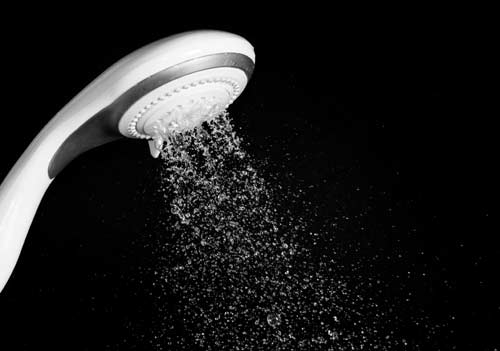
Shower with low pressure causes water to trickle out
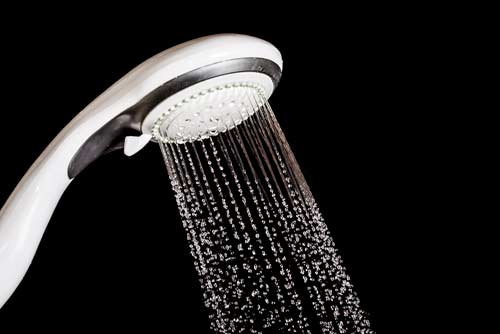
Shower with good water pressure causes water to flow freely
Ofwat (Office of Water Services) monitors the fact that any and all customers of any water and sewerage company are entitled to guaranteed minimum standards of service. These standards are contained in a Government Act which is called the guaranteed standards scheme (GSS).
If any company does not meet these standards then it is required to compensate customers. The payments due, under this compensation scheme are set out in the table below and further information about these payments can be seen here.
If my Water Pressure Meets Minimum Guidelines but I’m not Happy, how can I Increase it?
Low water pressure in the home can be a pain in the pipes.
A family house with two bathrooms, a dishwasher, washing machine and other appliances all competing for water leads to many a domestic dispute, but boosting water pressure does not have to be an insurmountable problem.
Let’s take a look at what can be done to solve this common problem.
To improve water pressure in your home, first work out what type of system you have.
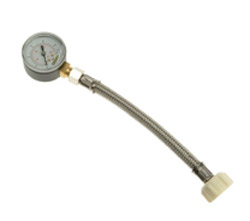
Check your water pressure is within the Ofwat guidelines – you can use a water pressure gauge
There are three common types in the UK:
Gravity-Fed Systems
sometimes referred to as low pressure systems, these use gravity to feed water through your home and can often be found in older properties that have not been modernised.
Mains water piped into the property takes two routes, the first to the kitchen cold tap, and the other to a cold water storage tank which you will usually find in your loft.
When you run a cold tap, water leaves the storage tank and goes straight to the outlet.
When you turn on a hot tap or an appliance that needs hot water, water leaves the tank and runs through a pipe towards the hot water cylinder, nearly always in your airing cupboard, and on to the hot water taps.
Getting enough water pressure to the shower is a particular problem if you have a gravity-fed system. If your cold water tank is situated only slightly above or somewhere lower than your shower head, water has to travel upwards which it obviously cannot do using gravity. Therefore, most gravity fed systems will benefit from a shower or whole house pump, if nothing else than to boost shower performance.
Combi-Boiler System
This system relies on mains pressure to deliver water round your home.
You will have a wall-hung boiler somewhere giving hot water on demand, and no cold water storage tank.
The boiler heats water without needing a water storage tank or a cistern and is sealed on the heating side, so the pressure of the mains water directly affects the flow of water through your taps and showers.
If you are receiving less than 12 litres of flow per minute into your property but more than 3 litres per minute, either all the time or at certain times of the day when demand for water in your street is high, then a mains water booster pump can probably help.
Many householders are confused between water pressure and water flow. Pressure is the force under which water is piped into your home.
Your local water authority has to supply at least 0.7 bar of pressure.
Water flow is the volume of water delivered into your home, usually measured in litres per minute.
To test your water flow simply take a 1-2 litre measuring jug, and run the problem tap or shower on full, timing how long it takes to fill the jug. If it is less than 10 litres a minute you have low mains water flow.
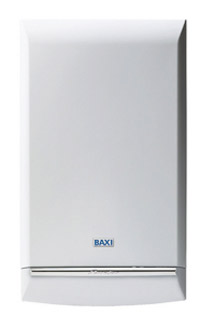
Combination boilers heat water when required
Unvented System
Often referred to as pressurised systems, these are supplied direct from the mains water supply and involve having a separate hot water cylinder complete with a small pressure vessel, which stores hot water at mains pressure.
If you have a boiler, a metal hot water storage tank and no cold water storage tank, you have probably got an unvented system.
Because this system is completely sealed, the mains water pressure directly affects the flow of water within your home.
So What can you do to fix Poor Water Pressure?
There are many factors that affect your water pressure. Cracked or damaged pipes, over-demand at peak times such as in the mornings, the position of showers and appliances especially with gravity-fed systems, or even the height of your property.
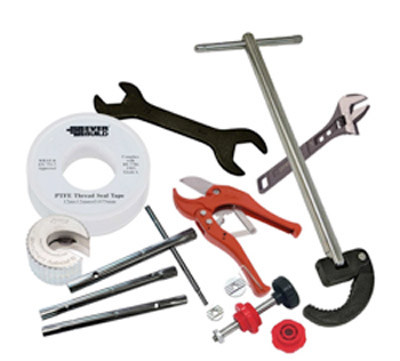
Do your own plumbing with this plumbers repair kit
If it is just your shower performing poorly and you have a combi boiler, check whether it is big enough to provide enough hot water.
Badly designed shower valves and fittings can also restrict the flow of water, and another really simple cause can be limescale build up on the shower head.
Increasing water pressure on a gravity-fed system involves finding out where your cold water storage tank is located.
If it is not already high up in the property, you can improve the pressure by moving the tank up into the loft and increasing how far the water has to fall.
Alternatively a shower or whole house pump can often solve the problem and provide power shower performance.
How can I see What Water System I Have at Home?
See our pages on hot and cold water systems here.
Using Water Pump to Increase Water Pressure
Upgrading your mains service or putting in larger water tanks can be costly and disruptive, and one of the simplest and least expensive solutions is to fit a home booster pump.
There are pumps on the market to suit all systems, even those in a negative head situation, i.e. where the shower is located above the cold water supply, and reputable manufacturers will have a technical team on hand to help you make the right choice.
Some pumps can be fitted by a competent DIYer, however it is recommended that a qualified installer/plumber is called on to ensure that the correct pump is chosen and fitted as per manufacturer guidelines.
If you feel capable of installing your own pump, there are a few important issues to bear in mind:
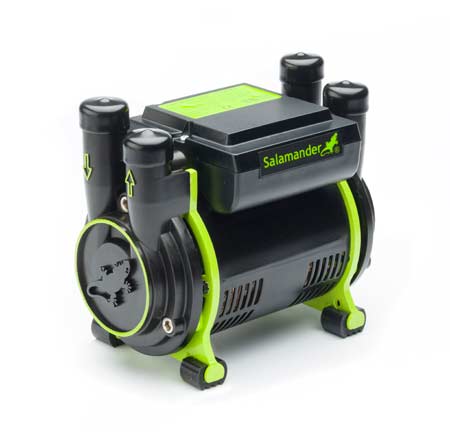
Twin impellow water pump used to increase water pressure in bathroom
How and Where to put a Water Pump
The pump location is critical as they are designed to push water rather than pull, so the further they are from the source the harder it is for them to get the water into the pump to generate enough pressure to push water around the property.
You also need to consider where the pipework is going to run as the hoses need to be the correct way around – angled hoses on the side and the straight hoses on the top – with a maximum bend of 30 degrees.
If the hoses are not correct this will put a strain on them and can cause them to fail, but if bent too far, can either starve the pump, or if on the outlets, hold the pressure in the pump, which can not only affect the pump performance but can also shorten its lifespan.
Checking and Inspecing Pipework
visually inspect the pipework to ensure there are no dead legs – sections of pipe that were previously used to supply an outlet but have now been capped off leaving a section of pipe unused.
This is because it can affect the operation of the pump but also as the section of pipe is no longer used it can become stagnant, posing a risk to health.
You also need to ensure you supply the pump in the correct size pipework, which will vary depending on the model you choose.
This is because different models produce a varied amount of flow and pressure, and to be able to operate correctly the water supply to them needs to be adequate to ensure consistent operation.
Depending on the number of outlets, your hot water cylinder supply pipework may need to be increased to 28mm pipework to keep up with the new demand.
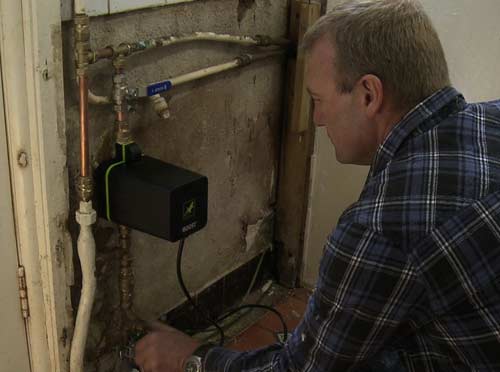
Plumbing in and connecting up the new pump using 15mm copper pipe and compression joints
Water Temperature to the Water Pump
It is essential to ensure the temperature of the water going into the pump is less than 60 degrees.
If this is exceeded it will cause the seals in the pump to set hard and no longer create an adequate seal, which may cause your pump to leak.
If you have a standard gas central heating boiler this can easily be controlled with a cylinder thermostat.
If you have an uncontrollable source of heat like solar or solid fuel, the hot feed to the pump must be controlled by the use of a blending valve, which will also need dedicated hot and cold feeds to ensure the supply through this is adequate for the pump.
How do I Know Which Water Pump I Need?
There is a great resource on the Salamander Pumps website on how to identify which water pump you need to boost your water pressure at home.
A different pump may be needed to increase the pressure in your shower as opposed to increasing the pressure from your bath tap.
Pressure Reducing Valve (PRV)
A pressure reducing valve is needed if the gravity hot water is being pumped with a single impeller pump and the cold water is mains fed to a mixer valve/tap.
PRV’s work by allowing water to flow into it them, so a spring loaded internal diaphragm can reduce the pressure to a pre-set level determined by the installer, which means you can correctly control the temperature of the water.
You can find out more about Pressure Reducing Valves here.
For instance, mains water usually comes between 1 and 4 bars, so if your hot water comes at 0.2 bars, to feel any benefit at all from the hot feed, you need to install a PRV.
If your mains pressure is high, use a PRV and then choose the pump that suits it.
Noise: Many householders are concerned about the noise of a water pump, but thanks to an industry-wide focus on continuous quality improvements there are quiet pumps available.
As an example, Salamander Pumps’ HomeBoost product, which in independent testing was rated as quieter than a boiling electric kettle, is just one of the company’s pumps to be awarded the international Quiet Mark award for its low noise operation.
Quiet Mark is the eco-award programme run by the UK Noise Abatement Society, which ranks excellence in quiet product design, and is only awarded to products proven to be some of the quietest in their class.
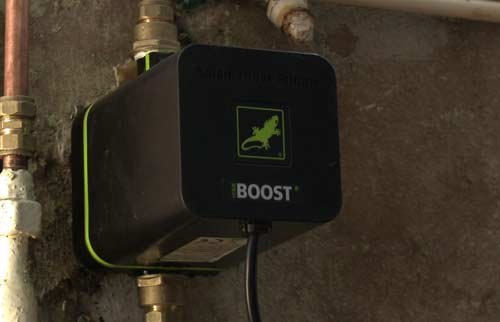
Increase home water pressure with Salamander’s Home Boost System
If you are suffering from water pressure problems, our advice is to identify what type of system you have, test the water flow, do your research into pumps and talk to a plumber or pump manufacturer about the best remedy for your home.

